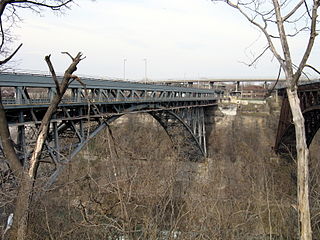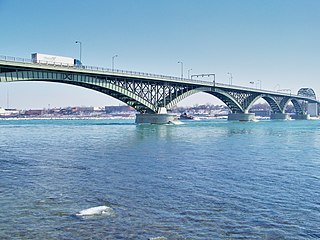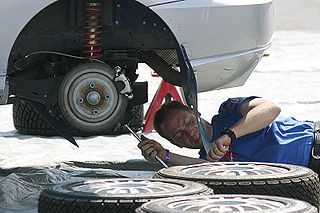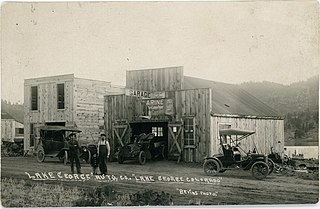
Bomb disposal is an explosives engineering profession using the process by which hazardous explosive devices are disabled or otherwise rendered safe. Bomb disposal is an all-encompassing term to describe the separate, but interrelated functions in the military fields of explosive ordnance disposal (EOD) and improvised explosive device disposal (IEDD), and the public safety roles of public safety bomb disposal (PSBD) and the bomb squad.

Open-pit mining, also known as open-cast or open-cut mining and in larger contexts mega-mining, is a surface mining technique that extracts rock or minerals from the earth.

Operation Paperclip was a secret United States intelligence program in which more than 1,600 German scientists, engineers, and technicians were taken from former Nazi Germany to the U.S. for government employment after the end of World War II in Europe, between 1945 and 1959. Most were former members and leaders of the Nazi Party.

An inspection is, most generally, an organized examination or formal evaluation exercise. In engineering activities inspection involves the measurements, tests, and gauges applied to certain characteristics in regard to an object or activity. The results are usually compared to specified requirements and standards for determining whether the item or activity is in line with these targets, often with a Standard Inspection Procedure in place to ensure consistent checking. Inspections are usually non-destructive.

Interstate 535 (I-535) is a 2.78-mile-long (4.47 km) auxiliary Interstate Highway spur route of I-35 in the US states of Minnesota and Wisconsin. It is paired with U.S. Highway 53 (US 53) along its entire route. The Interstate was part of the original 1956 Interstate Highway System and was completed in 1971. Since then, weight limits have been added to the Blatnik Bridge that carries the highway over Saint Louis Bay between Superior, Wisconsin, and Duluth, Minnesota.

The Whirlpool Rapids Bridge, commonly known as the Whirlpool Bridge or the Lower Steel Arch Bridge, is a spandrel braced, riveted, two-hinged arch bridge that crosses the Canada–United States border, connecting the commercial downtown districts of Niagara Falls, Ontario, and Niagara Falls, New York. This bridge is located approximately 1.5 kilometres (0.9 mi) north of the Rainbow Bridge and about 2 kilometres (1.2 mi) from the Falls. It was acquired by the Niagara Falls Bridge Commission in January 1959. Immediately upstream is the similar arch-style Michigan Central Railway Bridge, which has been out of service since 2001.

The Peace Bridge is an international bridge over the Niagara River between Canada and the United States, located just north of the river's source at the east end of Lake Erie about 20 kilometres (12.4 mi) upriver of Niagara Falls. It connects Buffalo, New York, in the United States to Fort Erie, Ontario, in Canada. It is operated and maintained by the bi-national Buffalo and Fort Erie Public Bridge Authority.
Construction site safety is an aspect of construction-related activities concerned with protecting construction site workers and others from death, injury, disease or other health-related risks. Construction is an often hazardous, predominantly land-based activity where site workers may be exposed to various risks, some of which remain unrecognized. Site risks can include working at height, moving machinery and materials, power tools and electrical equipment, hazardous substances, plus the effects of excessive noise, dust and vibration. The leading causes of construction site fatalities are falls, electrocutions, crush injuries, and caught-between injuries.

The Ministry of Transportation (MTO) is the provincial ministry of the Government of Ontario that is responsible for transport infrastructure and related law in Ontario, Canada. The ministry traces its roots back over a century to the 1890s, when the province began training Provincial Road Building Instructors. In 1916, the Department of Public Highways of Ontario (DPHO) was formed and tasked with establishing a network of provincial highways. The first was designated in 1918, and by the summer of 1925, sixteen highways were numbered. In the mid-1920s, a new Department of Northern Development (DND) was created to manage infrastructure improvements in northern Ontario; it merged with the Department of Highways of Ontario (DHO) on April 1, 1937. In 1971, the Department of Highways took on responsibility for Communications and in 1972 was reorganized as the Ministry of Transportation and Communications (MTC), which then became the Ministry of Transportation in 1987.

An autonomous underwater vehicle (AUV) is a robot that travels underwater without requiring continuous input from an operator. AUVs constitute part of a larger group of undersea systems known as unmanned underwater vehicles, a classification that includes non-autonomous remotely operated underwater vehicles (ROVs) – controlled and powered from the surface by an operator/pilot via an umbilical or using remote control. In military applications an AUV is more often referred to as an unmanned undersea vehicle (UUV). Underwater gliders are a subclass of AUVs.

An auto mechanic is a mechanic who services and repairs automobiles, sometimes specializing in one or more automobile brands or sometimes working with any brand. In fixing cars, their main role is to diagnose and repair the problem accurately and quickly. Seasoned auto repair shops start with a (Digital) Inspection to determine the vehicle conditions, independent of the customers concern. Based on the concern, the inspection results and preventative maintenance needs, the mechanic/technician returns the findings to the service advisor who then gets approval for any or all of the proposed work. The approved work will be assigned to the mechanic on a work order. Their work may involve the repair of a specific part or the replacement of one or more parts as assemblies. Basic vehicle maintenance is a fundamental part of a mechanic's work in modern industrialized countries, while in others they are only consulted when a vehicle is already showing signs of malfunction.

An automobile repair shop is an establishment where automobiles are repaired by auto mechanics and technicians. The customer interface is typically a service advisor, traditionally called a service writer.

"Pit of Peril" is the second episode of Thunderbirds, a British Supermarionation television series created by Gerry and Sylvia Anderson and filmed by their production company AP Films (APF) for ITC Entertainment. Written by Alan Fennell and directed by Desmond Saunders, it was first broadcast on 7 October 1965 on ATV Midlands.
The Thunderbirds machines are a series of fictional vehicles that appear in the mid-1960s film and television series Thunderbirds. The series was developed by Gerry and Sylvia Anderson. The series began with the Supermarionation television show Thunderbirds and was followed by the subsequent feature films Thunderbirds Are Go and Thunderbird 6, which were released between 1965 and 1968. The show featured a large variety of futuristic air, land, and sea vehicles and machines, most of which were designed by special effects director Derek Meddings.
"Path of Destruction" is the 28th episode of Thunderbirds, a British Supermarionation television series created by Gerry and Sylvia Anderson and filmed by their production company AP Films (APF) for ITC Entertainment. Written by Donald Robertson and directed by David Elliott, it was first broadcast on 9 October 1966 on ATV London and Anglia Television as the second episode of Series Two. It had its first UK-wide network broadcast on 24 April 1992 on BBC2.

An accident is an unintended, normally unwanted event that was not directly caused by humans. The term accident implies that nobody should be blamed, but the event may have been caused by unrecognized or unaddressed risks. Most researchers who study unintentional injury avoid using the term accident and focus on factors that increase risk of severe injury and that reduce injury incidence and severity. For example, when a tree falls down during a wind storm, its fall may not have been caused by humans, but the tree's type, size, health, location, or improper maintenance may have contributed to the result. Most car wrecks are not true accidents; however, English speakers started using that word in the mid-20th century as a result of media manipulation by the US automobile industry.
The Great Haigh Sough is a tunnel or adit driven under Sir Roger Bradshaigh's estate between 1653 and 1670, to drain his coal and cannel pits in Haigh on the Lancashire Coalfield. The sough's portal and two metres of tunnel from where it discharges water into the Yellow Brook at Bottling Wood is a scheduled monument.

Occupational safety and health (OSH) or occupational health and safety (OHS) is a multidisciplinary field concerned with the safety, health, and welfare of people at work. OSH is related to the fields of occupational medicine and occupational hygiene and aligns with workplace health promotion initiatives. OSH also protects all the general public who may be affected by the occupational environment.
Robotic non-destructive testing (NDT) is a method of inspection used to assess the structural integrity of petroleum, natural gas, and water installations. Crawler-based robotic tools are commonly used for in-line inspection (ILI) applications in pipelines that cannot be inspected using traditional intelligent pigging tools.

The Cobre mine was a copper mine in Cuba, the oldest in the new world. The open pit mine was operated from 1544 to 1998. The Spanish used slave labour and free coloured labour to work the mine. After it had been abandoned, in the 19th century a British company acquired the mine and reopened it, again using slaves and free coloured labourers, but also using skilled Cornish miners and steam engines from Cornwall to operate pumps. The mine was abandoned again, then reopened by an American company at the start of the 20th century. After the Cuban Revolution it was taken over by the state. After being finally abandoned the pit is now filled with a mineral-rich lake.
















